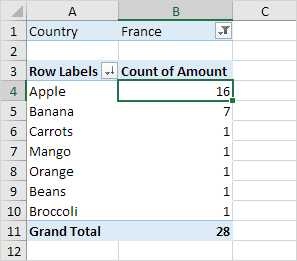
To do this, select cell A1 and type Order ID. Next in the VALUES section, click on the "Sum of Order ID" and drag it to the ROWS section.įinally, we want the title in cell A1 to show as "Order ID" instead of "Row Labels".


In this example, we've selected the checkboxes next to the Order ID and Quantity fields. When adding new rows or columns to your source data, you wont need. Next, choose the fields to add to the report. When creating a pivot table its usually a good idea to turn your data into an Excel Table. Your pivot table should now appear as follows: In this example, we've chosen cells A1 to F16 in Sheet1. Select the range of data for the pivot table and click on the OK button. In the Tables group, click on the Tables button and select PivotTable from the popup menu.Ī Create PivotTable window should appear. Next, select the INSERT tab from the toolbar at the top of the screen. HistoryEdit Excel 97 included a new and improved PivotTable Wizard, the ability to create calculated fields, and new pivot cache objects that allow developers. Believe it or not, we’re already to the point in the process when you can insert a pivot table. Before you start building anything in Excel, it’s smart to take a quick look at your data to ensure.

#Microsoft office pivot table tutorial how to
In this example, we've selected cell A1 on Sheet2. How to build a pivot table: A case study 1. Highlight the cell where you'd like to see the pivot table. El libro de Excel incluye una tabla llamada hosts.Hemos importado los hosts copiándolos y pegándolo en Excel, después han dado formato a los datos como una tabla. Agregar una relación mediante la vista de diagrama de Power Pivot. Question: How do I create a pivot table in Microsoft Excel 2013?Īnswer: In this example, the data for the pivot table resides on Sheet1. La cinta de opciones ahora contiene la pestaña POWER PIVOT.


 0 kommentar(er)
0 kommentar(er)
